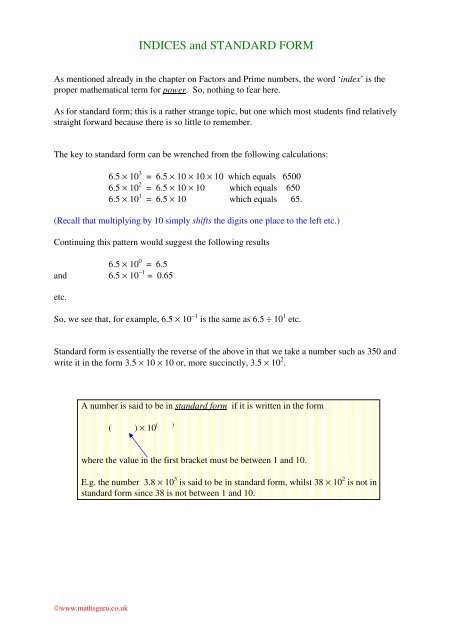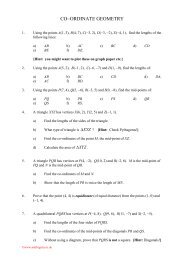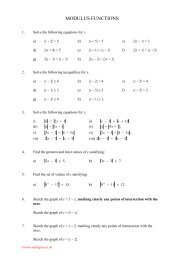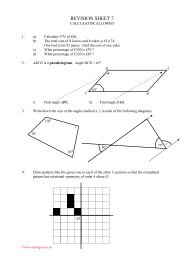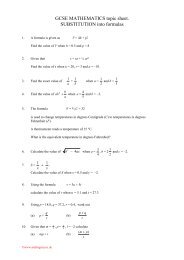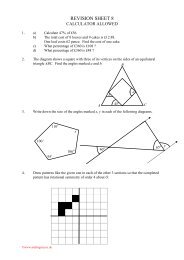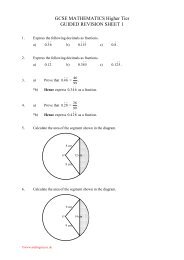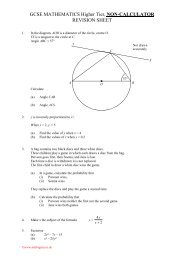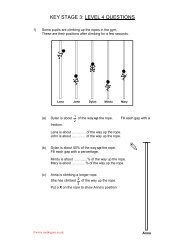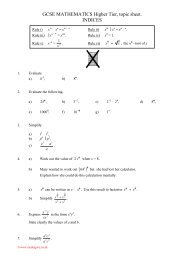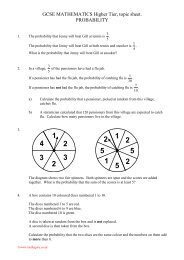INDICES and STANDARD FORM
INDICES and STANDARD FORM
INDICES and STANDARD FORM
Create successful ePaper yourself
Turn your PDF publications into a flip-book with our unique Google optimized e-Paper software.
<strong>INDICES</strong> <strong>and</strong> <strong>STANDARD</strong> <strong>FORM</strong><br />
As mentioned already in the chapter on Factors <strong>and</strong> Prime numbers, the word ‘index’ is the<br />
proper mathematical term for power. So, nothing to fear here.<br />
As for st<strong>and</strong>ard form; this is a rather strange topic, but one which most students find relatively<br />
straight forward because there is so little to remember.<br />
The key to st<strong>and</strong>ard form can be wrenched from the following calculations:<br />
6.5 × 10 3 = 6.5 × 10 × 10 × 10 which equals 6500<br />
6.5 × 10 2 = 6.5 × 10 × 10 which equals 650<br />
6.5 × 10 1 = 6.5 × 10 which equals 65.<br />
(Recall that multiplying by 10 simply shifts the digits one place to the left etc.)<br />
Continuing this pattern would suggest the following results<br />
6.5 × 10 0 = 6.5<br />
<strong>and</strong> 6.5 × 10 −1 = 0.65<br />
etc.<br />
So, we see that, for example, 6.5 × 10 −1 is the same as 6.5 ÷ 10 1 etc.<br />
St<strong>and</strong>ard form is essentially the reverse of the above in that we take a number such as 350 <strong>and</strong><br />
write it in the form 3.5 × 10 × 10 or, more succinctly, 3.5 × 10 2 .<br />
A number is said to be in st<strong>and</strong>ard form if it is written in the form<br />
( ) × 10 ( )<br />
where the value in the first bracket must be between 1 <strong>and</strong> 10.<br />
E.g. the number 3.8 × 10 3 is said to be in st<strong>and</strong>ard form, whilst 38 × 10 2 is not in<br />
st<strong>and</strong>ard form since 38 is not between 1 <strong>and</strong> 10.<br />
©www.mathsguru.co.uk
Example 1.<br />
Write the following numbers in st<strong>and</strong>ard form.<br />
a) 560, b) 56, c) 5.6, d) 0.56.<br />
Solution.<br />
a) In searching for a number between 1 <strong>and</strong> 10 to represent 560 we inevitably arrive<br />
at 5.60.<br />
It is then a short step to get to the fact that 560 = 5.6 × 100 or 5.6 × 10 2 .<br />
b) In a similar way to a), we see that 56 = 5.6 × 10 1 ,<br />
The answers for both c) <strong>and</strong> d) are obtained by following the obvious pattern in a) <strong>and</strong> b).<br />
c) 5.6 = 5.6 × 10 0 .<br />
d) 0.56 = 5.6 × 10 −1 .<br />
For a lot of people, st<strong>and</strong>ard form simply becomes a process of searching for a number<br />
between 1 <strong>and</strong> 10 <strong>and</strong> then counting how many times the digits must move in order to return<br />
to the original number etc. Well it works, <strong>and</strong> this close to an exam, I’m not going to argue!<br />
Try the following example for practice.<br />
Example 2.<br />
Write the following numbers in st<strong>and</strong>ard form.<br />
a) 3460, b) 105, c) 4.21, d) 0.016.<br />
Answers.<br />
a) 3460 = 3.46 × 10 3 b) 105 = 1.05 × 10 2<br />
c) 4.21 = 4.21 × 10 0 d) 0.016 = 1.6 × 10 −2 .<br />
NOTE.<br />
Computers <strong>and</strong> calculators use st<strong>and</strong>ard form when storing numbers in their memories since it<br />
allows for the storage of very large <strong>and</strong> very small decimal numbers.<br />
For example, the number 18 000 000 000 000 when written in st<strong>and</strong>ard form equates<br />
to 1.8 × 10 13 . A computer would simply store the values 1.8 <strong>and</strong> 13 as a way of remembering<br />
this value.<br />
©www.mathsguru.co.uk
Easy enough ?<br />
To make things easier, let us employ a calculator to check our answers.<br />
All we need are the power button, usually labelled , or sometimes , <strong>and</strong> the<br />
plus / minus button (not the subtract key).<br />
x y<br />
^<br />
For example, to key in 1.05 × 10 2 on a newish Casio calculator, press the following buttons:<br />
1 . 0 5 × 1 0 x y 2 =<br />
ANSWER should equal 105.<br />
Now try 1.6 × 10 −2 on your calculator.<br />
Press<br />
1 . 6 × 1 0 x y − 2 =<br />
ANSWER should equal 0.016.<br />
The minus key. NOT the subtract key.<br />
Now we can check our answers.<br />
WARNING. If your calculator display shows you a number like 1.6 −02 , then it is being lazy!<br />
Your calculator is actually referring to the number given by 1.6 × 10 −2 (which is the same as<br />
0.016), but thinks it is being clever by leaving out the ×10 ... etc.<br />
Similarly 2.4 −03 on your calculator display refers to the number 2.4 × 10 −3 (or 0.0024).<br />
So, look carefully at your calculator display !<br />
©www.mathsguru.co.uk
Example 3.<br />
Work out the following. Give your answers in st<strong>and</strong>ard form.<br />
a) (3 × 10 7 ) + (1.4 × 10 5 ), b) (9.9 × 10 6 ) × (2 × 10 −3 ),<br />
c)<br />
−7<br />
4.5 × 10<br />
.<br />
−3<br />
3 × 10<br />
Solution.<br />
a) On a calculator (assuming it works the same way as a newish Casio!), press the<br />
following keys:<br />
( 3 × 1 0 x y 7) + ( 1 . 4 × 1 0 x y 5 ) =<br />
to get an answer of 30140000. Now convert to st<strong>and</strong>ard form as requested to<br />
get 3.014× 10 7 .<br />
b) Again simply use a calculator, including the bracket buttons, to get an answer<br />
of 19800.<br />
Convert to st<strong>and</strong>ard form to get 1.98 × 10 4 .<br />
c) Comment. This question ( is trying to catch us out by not putting brackets in. Let us<br />
−7<br />
4.5 × 10 )<br />
rewrite it correctly: . Now we simply grab a calculator!<br />
−3<br />
3 × 10<br />
Press the following keys:<br />
( )<br />
( 4 . 5 × 1 0 x y − 7 ) ÷ ( 3 × 1 0 x y − 3 ) =<br />
Minus button! NOT the subtract key.<br />
Answer = 0.00015 or, in st<strong>and</strong>ard form, 1.5 × 10 −4 .<br />
Comment.<br />
If your calculator is being lazy <strong>and</strong> displays the answer, 1.5 −04 , then simply remember<br />
to put in the ×10 <strong>and</strong> give your answer as 1.5 × 10 −4 . You see, not so daft after all<br />
these calculators !<br />
These days, GCSE examiners have a rather nasty habit of occasionally throwing the above<br />
types of calculations in the direction of the NON-CALCULATOR papers!<br />
Still, not to worry. I’ve included a whole bunch of these in the exercise below, which I advise<br />
you to stare at for a few days <strong>and</strong> nights <strong>and</strong> seek out your teacher if you require a more vocal<br />
explanation.<br />
©www.mathsguru.co.uk
Example 4.<br />
Light travels at approximately 298 000 km per second.<br />
a) Find the speed of light in km per hour <strong>and</strong> write your answer in<br />
st<strong>and</strong>ard form.<br />
b) The distance between the Sun <strong>and</strong> The Earth is approximately 143 000 000 km.<br />
Find, to the nearest minute, the time taken for sunlight to reach the Earth.<br />
Solution.<br />
a) We are given that light travels 298 000 km every second. Well this means that light<br />
must travel 60 × 298000 = 17880000 km every minute.<br />
Therefore, light must travel 60 × 17880000 km = 1072800000 km every hour.<br />
Converting to st<strong>and</strong>ard form gives us an answer of 1.0728 × 10 9 km per hour.<br />
{Again, if your calculator simply shows you an answer of 1.0728 09 then don’t forget to<br />
write in the ×10 ... etc.}<br />
b) We know from part a) that light travels 17880000 km every minute.<br />
Thus, the number of minutes required for light to travel the 143 000 000 km between<br />
the Sun <strong>and</strong> the Earth is given by 143000000 = 7.9977... minutes.<br />
17880000<br />
This gives a time of 8 minutes to the nearest minute.<br />
©www.mathsguru.co.uk
Exercise 1.<br />
1) Write the following numbers in st<strong>and</strong>ard form.<br />
a) 35, b) 4210, c) 125⋅002,<br />
d) 9⋅2, e) 125000, f) 8,<br />
g) 0⋅025, h) 0⋅00167, i) 100,<br />
j) 1, k) 251.<br />
2) Work out the following. Give your answers in st<strong>and</strong>ard form.<br />
a) (3.5 × 10 7 ) + (2⋅6 × 10 5 ), b) (3⋅9 × 10 6 ) × (2.1 × 10 −3 ),<br />
c)<br />
2<br />
( 3×<br />
10 )<br />
3<br />
( 3×<br />
10 −<br />
)<br />
, d) (4⋅25×10 6 ) − (3⋅456×10 4 ),<br />
e) (7⋅29×10 12 ) ÷ (3⋅5×10 8 ), f)<br />
g) (3.2 × 10 4 ) × (2.5 × 10 3 ), h)<br />
3.6 × 10 .<br />
5<br />
i) ( ) 3<br />
4<br />
( 36×<br />
10 )<br />
3<br />
( 8⋅ 5×<br />
10 )<br />
8.6 ×<br />
6<br />
10<br />
4.3 × 10 −<br />
,<br />
3<br />
,<br />
3) The following numbers have been written in st<strong>and</strong>ard form. Write each in decimal<br />
form. a) 3.5 × 10 6 , b) 8.2 × 10 −3 .<br />
4) Find, in st<strong>and</strong>ard form, the values of<br />
a) (3 × 10 2 ) × (2 × 10 3 ), b) (4 × 10 2 ) × (2 × 10 4 ),<br />
c) (3 × 10 3 ) × (3 × 10 5 ), d) (3.1 × 10 7 ) × (2 × 10 3 ),<br />
e) (4.3 × 10 2 ) × (2 × 10 6 ), f) (3.2 × 10 5 ) × (3 × 10 −2 ),<br />
g) (3.3 × 10 −2 ) × (3 × 10 −1 ), h) (4.8 × 10 −3 ) × (2 × 10 −2 ),<br />
i) (1.5 × 10 −2 ) × (4 × 10 5 ).<br />
5) Find, in st<strong>and</strong>ard form, the values of<br />
a) (6 × 10 2 ) × (2 × 10 3 ), b) (9 × 10 2 ) × (2 × 10 4 ),<br />
c) (6 × 10 3 ) × (3 × 10 5 ), d) (8 × 10 7 ) × (5 × 10 3 ),<br />
e) (25 × 10 2 ) × (5 × 10 6 ), f) (30 × 10 5 ) × (4 × 10 −2 ),<br />
g) (3.1 × 10 4 ) × (6 × 10 −1 ), h) (7.8 × 10 5 ) × (2 × 10 −2 ),<br />
i) (12 × 10 3 ) × (11 × 10 5 ).<br />
©www.mathsguru.co.uk
ANSWERS / SOLUTIONS.<br />
1) a) 3⋅5 × 10 1 , b) 4⋅21 × 10 3 , c) 1⋅25002 × 10 2 ,<br />
d) 9⋅2 × 10 0 , e) 1⋅25 × 10 5 , f) 8×10 0 ,<br />
g) 2⋅5 × 10 −2 , h) 1⋅67 × 10 −3 , i) 1 × 10 2 ,<br />
j) 1 × 10 0 , k) 2⋅51 × 10 2 .<br />
NOTE that there appears to be 2 possible answers for the number 100, namely<br />
1 × 10 2 or 10 × 10 1 .<br />
Only 1 × 10 2 is correct since we do not allow a 10 × .... etc.<br />
2) a) 3.526 × 10 7 , b) 8.19 × 10 3 , c) 1 × 10 5 ,<br />
d) 4⋅21544 × 10 6 , e) 2⋅0828571 × 10 4 , f) 4⋅2352941 × 10 1 ,<br />
g) 8 × 10 7 , h) 2 × 10 9 , i) 4.6656 × 10 16 .<br />
Remember to put the brackets in part h). Also, beware of your calculator leaving out<br />
the ×10 ... etc.<br />
3) a) 3500000, b) 0.0082.<br />
Comment regarding questions 4 <strong>and</strong> 5). NO CALCULATORS !!!<br />
These do not turn up frequently enough that you should be overly concerned if you<br />
find them difficult. Just be prepared to have a go.<br />
For example, (3 × 10 2 ) × (2 × 10 3 ) can be written (3 × 10 × 10) × (2 × 10 × 10 × 10)<br />
which simplifies to give the answer of 6 × 10 5 .<br />
(3 × 10 2 ) × (2 × 10 3 )<br />
Simply staring at the questions in conjunction with the answers below might do the<br />
job! Failing that, ask your teacher !<br />
4) a) 6 × 10 5 , b) 8 × 10 6 , c) 9 × 10 8 ,<br />
d) 6.2 × 10 10 , e) 8.6 × 10 8 , f) 9.6 × 10 3 ,<br />
g) 9.9 × 10 −3 , h) 9.6 × 10 −5 , i) 6 × 10 3 .<br />
5) a) 1.2 × 10 6 , b) 1.8 × 10 7 , c) 1.8 × 10 9 ,<br />
d) 4 × 10 11 , e) 1.25 × 10 10 , f) 1.20 × 10 5 ,<br />
g) 1.86 × 10 4 , h) 1.56 × 10 4 , i) 1.32 × 10 10 .<br />
©www.mathsguru.co.uk


